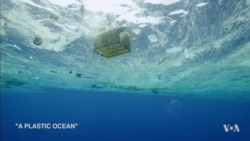Plastic sludge and garbage, a blight on the world’s oceans.
Eight million metric tons of plastic wind up each year in the oceans, harming marine life and entering the food chain.
A film crew traveled the globe to document the rubbish, producing a new documentary film called A Plastic Ocean that looks at the problem, and its solutions.
Julie Andersen of the Plastic Oceans Foundation said what is seen is just the tip of the problem.
“Half of the waste actually sinks to the bottom, some plastic sinks to the bottom, and what remains on the surface actually breaks down," Andersen said.
The filmmakers found trash in ocean gyres, the circulating currents that trap large concentrations of pollution in the Atlantic, Indian, and Pacific Oceans, home of what some have called a plastic island.
“What we found in the center of the Pacific was not a floating island of plastic. What we found was a plastic smog that permeated all the water," Andersen said.
The debris infects the food chain, sometimes visibly, and more so at the microscopic level, where the plastic particles interact with other pollutants.
Adam Leipzig, producer of A Plastic Ocean, said, “Heavy metals, pharmaceuticals, industrial runoff. It acts like magnets. These toxins hitchhike on the plastic, and when seafood ingests the plastics, those toxins offload into the fatty tissues.”
Those fish are then consumed by other sea life and by people.
China, Indonesia, the Philippines, Thailand and Vietnam are the worst plastic polluters. The United States, although a leader in recycling, is in the top 20, since it produces and consumes so much plastic.
There are efforts around the world to address the problem, including at this newly opened recycling center in Lebanon.
But Andersen said there is more people can do.
“Cut back on single-use plastics, straws, plastic cups, plastic water bottles, plastic bags and find alternatives like reusable materials," she said.
She said healthy oceans are essential to our survival.








